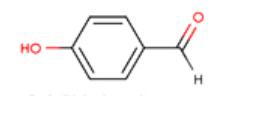As an important intermediate in organic synthesis, p-hydroxybenzaldehyde is widely used in fine chemical products such as medicine, perfume, electroplating, food and pesticide.
It is used in the synthesis of industrial perfume, such as eugenol, fennel, etc.

It is an important to fine chemical product and intermediate for organic synthesis, with wide use in pharmaceutical, aromatizer, pesticide, electroplating, and liquid crystal industries. In the pharmaceutical industry, it can be used to synthesize intermediates of sulfonamides such as broad-spectrum sterilization synergist TMP, ampicillin and semi-synthesized penicillin (oral) as well as intermediate of d-(-)-p-hydroxyphenyl picramate. In the aromatizer industry, it is mainly used in raspberry ketone, methyl vanillin, ethyl vanillin, anisic aldehyde and nitrile aromatizer. In the pesticide industry, it is mainly used to synthesize new-type insecticide, herbicide, o-bromobenzonitrile and hydroxyl carbon. In the electroplating industry, it can be used as a new-type cyanogens-free electroplating brightener.
| Density | 1.226g/cm3 |
| Product Name | 4-Hydroxybenzaldehyde; p-Hydroxybenzaldehyde; PHBA; |
| CAS No. | 123-08-0 |
| Molecular Formula | C7H6O2 |
| Molecular weight | 122.1213 |
Index name | Index Value | ||
Appearance | Electron Grade | Medical Grade | Spices Grade |
white crystalline powder | The pale yellow crystalline powder | The pale yellow crystalline powder | |
Purity:% | ≥99.8 | ≥99.5 | ≥99 |
Moisture:% | ≤0.3 | ≤0.3 | ≤0.5 |
Melting point:℃ | 115.5~118 | 115~118 | 114.5~116.5 |
Chloride: PPm | ≤50 | ≤50 | |
Heavy metal: PPm | ≤8 | ≤8 | |
Insoluble % | ≤0.05 | ≤0.05 | |
There are three isomers of hydroxybenzaldehyde, namely, o-hydroxybenzaldehyde, p-hydroxybenzaldehyde and m-Hydroxybenzaldehyde. P-hydroxybenzaldehyde is also known as p-formaldehyde phenol. The precipitates from water are white to light yellow acicular crystals. It has a fragrant smell. It can be sublimated without decomposition under normal pressure. The molecular weight was 122.12. The melting point is 115-116 ℃. The relative density was 1.129 (130 / 4 ℃). The refractive index is 1.5705 (130 ℃). The solubility is 1.38 at 30.5 ℃ and 3.68 in benzene at 65 ℃. Mice were intraperitoneally injected with ld50500 mg/kg. P-hydroxybenzaldehyde is an important intermediate of medicine, perfume and liquid crystal. Anisaldehyde can be prepared by reaction with dimethyl sulfate, p-hydroxycinnamaldehyde can be obtained by reaction with acetaldehyde, and cinnamic acid can be obtained by further oxidation. This product can be used as a perfume, pharmaceutical intermediate, liquid crystal raw material and another organic synthesis intermediate Body, widely used. In addition to being directly used as a perfume, m-Hydroxybenzaldehyde is also used as an intermediate in the production of other spices; pharmaceutical raw materials, such as the production of adrenaline hydrochloride, epinephrine, quinine, etc.; nickel plating brightener; chemical analysis reagent (quantitative analysis of sugar); photographic emulsion and bactericide, etc. O-hydroxybenzaldehyde, also known as salicylaldehyde, is a colorless, transparent, oily liquid, with the special smell and bitter almond flavor. It has active chemical properties and can take place in substitution, condensation, oxidation, Wittig reaction, etc. It is orange-red with sulfuric acid and forms a colored chelate with metal ions. It turns purple in the presence of ferric chloride solution. It can be reduced to salicylic alcohol. It is mainly used as raw material for producing perfume "coumarin" and "Dihydrocoumarin", preparing violet flavor, and also used as a bactericide. Preparation of p-hydroxybenzaldehyde: chloroform reacted with sodium phenol at 60 ℃. Or by condensation of phenol and Trichloroacetaldehyde catalyzed by potassium carbonate, and then decomposed by sodium methoxide. In addition, dry hydrogen chloride can be introduced into the mixture of phenol and hydrocyanic acid under the catalyst of aluminum trichloride and then decomposed in ice water to produce p-hydroxybenzaldehyde.
It is used in the synthesis of medicine and organic compounds. It is used as an important intermediate of medicine, perfume and pesticide. It is used in the synthesis of ampicillin, Trimethoxybenzaldehyde and other pharmaceutical uses. It is the intermediate of medicine, perfume and liquid crystal. P-hydroxybenzaldehyde is used in the production of antibacterial synergist TMP (trimethoprim), ampicillin, cephalosporin, artificial Gastrodia elata, Rhododendron, bezafibrate and esmolol; it is used to produce anisaldehyde, vanillin, ethyl vanillin and raspberry ketone. Chemical book is used as the key raw material for the production of p-hydroxyphenylglycoside (p-hydroxyphenylglycoside is the key intermediate of the new generation of semi-synthetic penicillin). At the same time, it is also the key intermediate raw material for the production of pesticide bromobenzonitrile. Application p-hydroxybenzaldehyde is an important intermediate in the pharmaceutical industry and perfume industry. It is used as an important intermediate of medicine, perfume and pesticide. It is used in the synthesis of benzylpenicillin, Trimethoxybenzaldehyde and other drugs. Polymer and pharmaceutical raw materials. Uses as raw materials for polymers and
